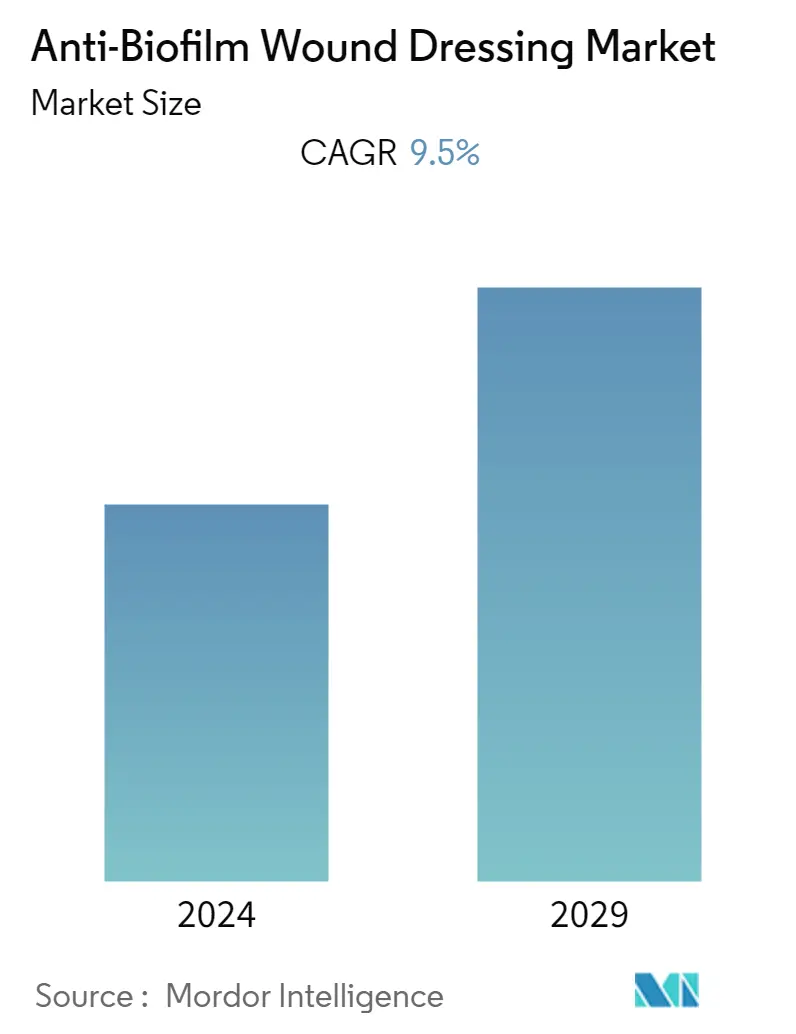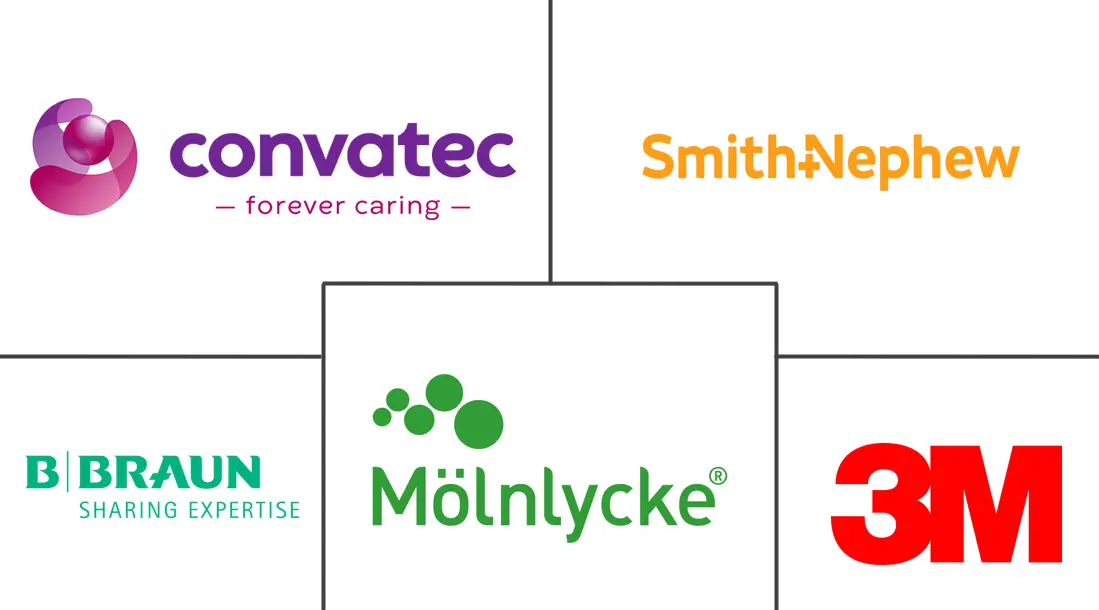Market Size of Anti-Biofilm Wound Dressing Industry

| Study Period | 2019 - 2029 |
| Base Year For Estimation | 2023 |
| CAGR | 9.50 % |
| Fastest Growing Market | Asia-Pacific |
| Largest Market | North America |
| Market Concentration | Medium |
Major Players
*Disclaimer: Major Players sorted in no particular order |
Anti-Biofilm Wound Dressing Market Analysis
The anti-biofilm wound dressing market is expected to register a CAGR of 9.5% over the forecast period.
- The COVID-19 pandemic had a significant impact on the anti-biofilm wound dressing market as the majority of the healthcare facilities were occupied with the management of COVID-19 patients. The elective procedures were postponed during the initial phase of the lockdown, which significantly impacted wound care management. The number of patient visits reported a substantial decline during the lockdown period. According to a study conducted by Ludwig Maximilian University, Munich, Germany, around 23% of patients suffering from chronic wounds were not able to visit physicians due to the pandemic. Moreover, around 10% of respondents avoided doctor visits as a precaution.
- The increased use of telehealth in the management of chronic and acute wounds was responsible for the strong recovery of the market. Various healthcare providers developed telehealth platforms in order to effectively manage patients suffering from acute and chronic wounds. For instance, in January 2021, Wound Pros Inc. developed a telehealth platform for communication between patients and professionals. The provider also invented an app named "RITA," which helps in new diagnostic and wound measurement.
- The unhealed wounds caused by chronic diseases (such as diabetes, venous, or arterial disorders) show bacterial contamination film on the wound surface. The growing cases of chronic and acute wounds are expected to drive the growth of the market during the forecast period. According to the research published by National Center for Biotechnology Information in June 2022, the global prevalence of pressure ulcers is close to 12.8%, with hospital-acquired pressure injury (HAPI) accounting for 8.4% of patients.
- Moreover, the evolving healthcare infrastructure in developing countries across the globe, technological advancements in the field of wound management, and combined initiatives taken by key players and healthcare providers to increase awareness about wound care are also supporting the market's growth. For instance, in February 2022, Asep Medical Holdings Inc. announced positive outcomes related to the Antibiofilm/Anti-inflammatory Peptide Technology developed with the help of the United States Army Medical Research and Materiel Command.
- These are the key factors expected to drive the demand for advanced wound dressing solutions, including anti-biofilm products, in the near future. However, high costs associated with wound care treatment, along with the scarcity of skilled professionals, are anticipated to impede the growth of the market.
Anti-Biofilm Wound Dressing Industry Segmentation
The various agents, including novel, non-invasive means of physical debridement, chemical agents, and biological agents, that are useful in the dressing of bacterial biofilm are covered in the report.
The anti-biofilm wound dressing market is segmented by mechanism (physical, chemical, biological), wound type (chronic wounds and acute wounds), end-user (hospitals and clinics, surgical centers, and other end-users), and geography (North America, Europe, Asia-Pacific, Middle East and Africa, and South America). The study also covers the estimated market sizes and trends for 17 different countries across major regions globally. The report offers the value (in USD million) for the above segments.
| By Mechanism | |
| Physical | |
| Chemical | |
| Biological |
| By Wound Type | ||||||
| ||||||
| Acute Wounds |
| By End User | |
| Hospitals and Clinics | |
| Surgical Centers | |
| Other End Users |
| By Geography | ||||||||
| ||||||||
| ||||||||
| ||||||||
| ||||||||
|
Anti-Biofilm Wound Dressing Market Size Summary
The anti-biofilm wound dressing market is poised for substantial growth, driven by the increasing prevalence of chronic and acute wounds, such as those caused by diabetes and pressure ulcers. The market's recovery post-COVID-19 pandemic is attributed to the rise of telehealth solutions, which facilitated continued patient care despite initial lockdowns. Technological advancements and evolving healthcare infrastructures, particularly in developing regions, are further propelling market expansion. Key players in the industry are actively developing innovative products, such as those incorporating iodine and ionic silver, to enhance wound care management. However, challenges such as high treatment costs and a shortage of skilled professionals may hinder market growth.
North America is expected to lead the market, supported by the availability of advanced wound care products and a growing number of specialized clinics. The presence of major market players and favorable reimbursement policies in the region contribute to its dominance. The increasing incidence of road accidents and the associated rise in wound care expenditure also bolster market growth in this region. The competitive landscape is moderately fragmented, with several international and regional companies holding significant market shares. Strategic acquisitions and product launches by key players are anticipated to further strengthen their positions in the market.
Anti-Biofilm Wound Dressing Market Size - Table of Contents
-
1. MARKET DYNAMICS
-
1.1 Market Overview
-
1.2 Market Drivers
-
1.2.1 Increasing Prevalence of Chronic Wounds
-
1.2.2 Introduction of Innovative Products in Advanced Wound Care
-
1.2.3 Surge in the Number of Surgical Procedures
-
-
1.3 Market Restraints
-
1.3.1 High Product Cost Along with the Increasing Utilization of Substitutes
-
-
1.4 Industry Attractiveness - Porter's Five Force Analysis
-
1.4.1 Threat of New Entrants
-
1.4.2 Bargaining Power of Buyers/Consumers
-
1.4.3 Bargaining Power of Suppliers
-
1.4.4 Threat of Substitute Products
-
1.4.5 Intensity of Competitive Rivalry
-
-
-
2. MARKET SEGMENTATION (Market Size by Value - USD million)
-
2.1 By Mechanism
-
2.1.1 Physical
-
2.1.2 Chemical
-
2.1.3 Biological
-
-
2.2 By Wound Type
-
2.2.1 Chronic Wounds
-
2.2.1.1 Diabetic Foot Ulcers
-
2.2.1.2 Pressure Ulcers
-
2.2.1.3 Venous Leg Ulcers
-
2.2.1.4 Other Chronic Wounds
-
-
2.2.2 Acute Wounds
-
-
2.3 By End User
-
2.3.1 Hospitals and Clinics
-
2.3.2 Surgical Centers
-
2.3.3 Other End Users
-
-
2.4 By Geography
-
2.4.1 North America
-
2.4.1.1 United States
-
2.4.1.2 Canada
-
2.4.1.3 Mexico
-
-
2.4.2 Europe
-
2.4.2.1 Germany
-
2.4.2.2 United Kingdom
-
2.4.2.3 France
-
2.4.2.4 Italy
-
2.4.2.5 Spain
-
2.4.2.6 Rest of Europe
-
-
2.4.3 Asia-Pacific
-
2.4.3.1 China
-
2.4.3.2 Japan
-
2.4.3.3 India
-
2.4.3.4 Australia
-
2.4.3.5 South Korea
-
2.4.3.6 Rest of Asia-Pacific
-
-
2.4.4 Middle East and Africa
-
2.4.4.1 GCC
-
2.4.4.2 South Africa
-
2.4.4.3 Rest of Middle East and Africa
-
-
2.4.5 South America
-
2.4.5.1 Brazil
-
2.4.5.2 Argentina
-
2.4.5.3 Rest of South America
-
-
-
Anti-Biofilm Wound Dressing Market Size FAQs
What is the current Anti-Biofilm Wound Dressing Market size?
The Anti-Biofilm Wound Dressing Market is projected to register a CAGR of 9.5% during the forecast period (2024-2029)
Who are the key players in Anti-Biofilm Wound Dressing Market?
Convatec Inc., Smith+Nephew, 3M, B. Braun SE and Mölnlycke Health Care AB are the major companies operating in the Anti-Biofilm Wound Dressing Market.

